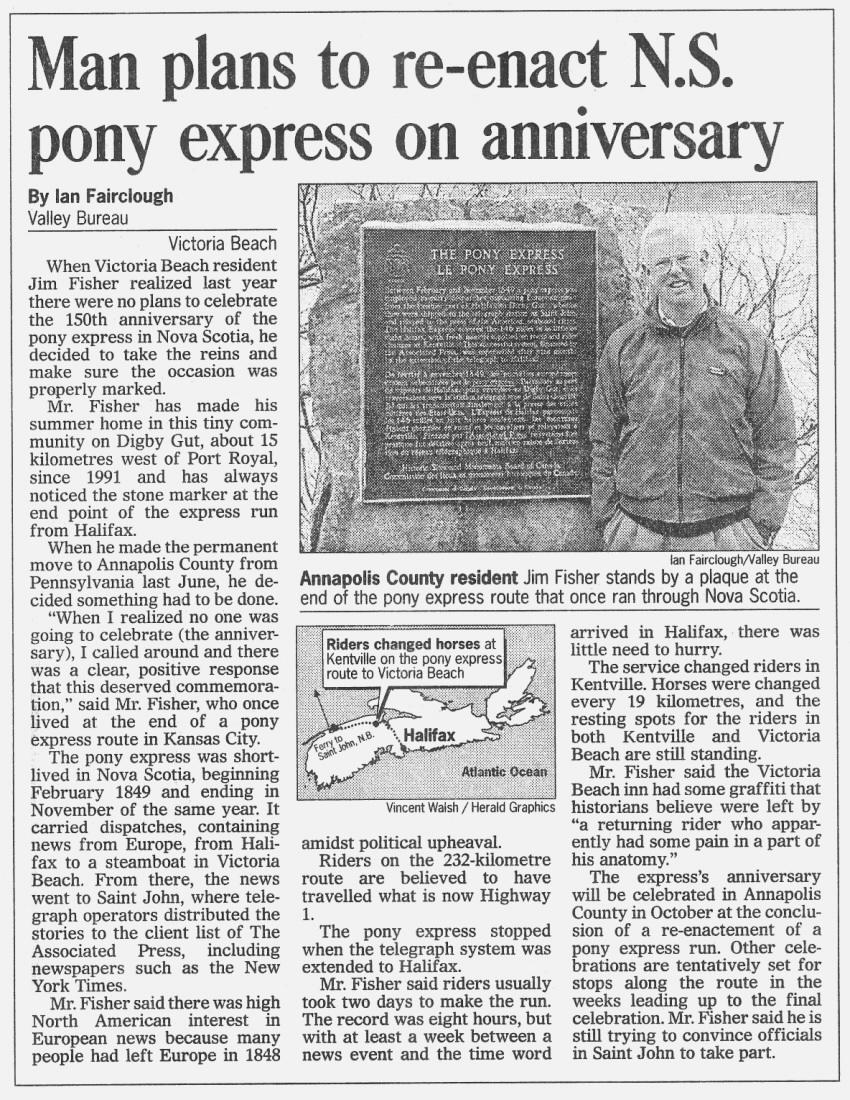at the Pony Express monument in Victoria Beach, Nova Scotia

Above: Front Below: Back



QSL cards are used by radio amateurs as a courtesy to other "hams" we contact. QSL means "verification" — the card verifies a valid two-way radio contact and can be used for a variety of purposes ranging from colorful wall decorations around the ham operating position to evidence for special radio amateur awards and certificates. One of the highly prized awards is the "DX Century Club" — which requires contacts with at least 100 countries. Dale did that in one weekend!
Note that his two-way radio amateur contacts with over 1800 amateurs in 102 countries in one weekend were all made in Morse code. This gives a different message than the "Morse Code is dead" news recently passed around, which really referred to a narrow set of military and ship-to-shore operations. It was also highly appropriate that this telegraphy-related historical event was celebrated in Morse code.
The XJ1JF call, obtained through the kind cooperation of the Fundy Amateur Radio Club and Industry Canada, continues to be in use in international amateur radio contacts through this coming November. 5,000 of these cards have been printed and I expect them all to find happy homes in ham households around the world, providing a lasting and widespread memento of the Nova Scotia Pony Express.

|
Note by ICS, 10 October 2006: This article is reasonably accurate
historically, but there are two points that need correction. • "...with at least a week between a news event (happening in Europe) and the time word arrived in Halifax, there was little need to hurry." This is wrong, wildly wrong. The time delay, "at least a week" between an event in Europe and the arrival of the news in Halifax, was totally irrelevant to the operation of the Halifax Express, a.k.a. the Nova Scotia Pony Express. The reason for the operation of this very expensive Express service, between Halifax and Victoria Beach, was to get the news to the New York newspapers as fast as possible. That was the whole point. It did not matter how long it took ("at least a week") to get across the North Atlantic Ocean to Halifax. (The actual time in 1849 was usually 10 to 12 days.) The objective was to get from Halifax to New York as fast as could be done in 1849. An hour was very important to the New York newspapers, so important that James Gordon Bennett, the owner of the New York Herald, in the mid-1840s was willing to pay a bonus of a hundred dollars for every hour that the Herald got an important news item from Europe ahead of the other New York newspapers. (Remember, at that time a hundred dollars was a fairly good annual income for a working man.) • "...riders usually took two days to make the run (from Halifax to Victoria Beach)." The riders usually took about twelve hours, not two days. The news package usually took no more than about sixteen hours all the way from Halifax to Saint John. The trip by steamship across the Bay of Fundy took around four to five hours, so the riders usually arrived in Victoria Beach in about eleven to twelve hours from Halifax. Here are the actual times for a few typical trips: The Second Pony Express Run departed Halifax: about 3am Thursday, March 8th, 1849 arrived Saint John: about 6pm Thursday, March 8th, 1849 travelling time, Halifax to Saint John: about 15 hours The Third Pony Express Run departed Halifax: about 11pm Thursday, March 15th, 1849 arrived Saint John: about 3pm Friday, March 16th, 1849 travelling time, Halifax to Saint John: 15 hours 30 minutes Pony Express Run departed Halifax: about 11am Tuesday, April 17th, 1849 arrived Saint John: about 3am Wednesday, April 18th, 1849 travelling time, Halifax to Saint John: 15 hours 20 minutes Pony Express Run departed Halifax: about 7pm Thursday, July 19th, 1849 arrived Saint John: noon Friday, July 20th, 1849 travelling time, Halifax to Saint John: about 17 hours Pony Express Run departed Halifax: noon Tuesday, September 25th, 1849 arrived Saint John: 4am Wednesday, September 26th, 1849 travelling time, Halifax to Saint John: about 16 hours |
More About the
|